#sir david's long beaked echidna
Explore tagged Tumblr posts
Text
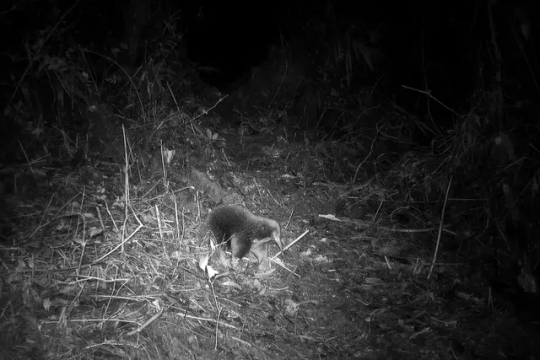
In more good news, the Sir David's long-beaked echidna, made an appearance on an expedition team's trail cams! This species hasn't been documented in over 60 years, and was thought to be extinct. This is also the first time a live specimen has been photographed/recorded, as the species was only identified in 1961 by a single dead specimen.
3K notes
·
View notes
Text
The Best News of Last Week - 13 November
🦔 - Who knew Attenborough's echidna was just camera-shy?
1. New state law prevents animal abuse offenders from owning pets

The law bans those convicted of animal cruelty, including those involved with dogfighting, from owning any kind of animal for five years after their first criminal offense.
2. A door at a Swedish library was accidentally left open — 446 people came in, borrowed 245 books. Every single one was returned

The library was supposed to be closed for All Saints Day — a celebration sometimes also called All Hallows Day, the precursor of Halloween. But the library staff had forgotten to close a door. So people came in, thinking the library was open. Some visitors realized the library was technically closed and went home, but others did not.
3. Ohio votes to legalize marijuana for adult recreational use, becoming 24th state to do so

Ohio voters approved a measure legalizing recreational marijuana on Tuesday, defying Republican legislative leaders who had failed to pass the proposed law.
Passage of Issue 2 makes Ohio the 24th state to allow adult cannabis use for non-medical purposes.
4. First ever images prove 'lost echidna' not extinct

Scientists have filmed an ancient egg-laying mammal named after Sir David Attenborough for the first time, proving it isn't extinct as was feared.
An expedition to Indonesia led by Oxford University researchers recorded four three-second clips of Attenborough's long-beaked echidna. Spiky, furry and with a beak, echidnas have been called "living fossils".
They are thought to have emerged about 200 million years ago, when dinosaurs roamed the Earth.
5. Dog leads family to missing cat that fell into 30-metre mineshaft

An incredibly lucky cat has his canine companion to thank for saving his life after the dog led rescuers to a 30 metre-deep mineshaft the cat fell into.
The cat, Mowgli, disappeared on Oct. 20 and had been missing for six days. Owner Michele Rose told the BBC that she had “almost given up hope” of finding her cat.
6. World’s first whole eye and partial face transplant gives Arkansas man new hope

A surgical team at NYU Langone Health in New York has performed the world’s first successful whole-eye transplant in a living person: Aaron James.
After an accident at work led to the loss of his left eye and part of his face, Aaron was given a new window to his soul, as well as a partial face transplant.
7. Obesity drug Wegovy cut risk of serious heart problems by 20%, study finds

The popular weight-loss drug Wegovy reduced the risk of serious heart problems by 20% in a large, international study that experts say could change the way doctors treat certain heart patients.
The research is the first to document that an obesity medication can not only pare pounds, but also safely prevent a heart attack, stroke or a heart-related death in people who already have heart disease — but not diabetes.
---
That's it for this week :)
This newsletter will always be free. If you liked this post you can support me with a small kofi donation here:
Buy me a coffee ❤️
Also don’t forget to reblog this post with your friends.
414 notes
·
View notes
Text
Good news! Zaglossus attenboroughi, Attenborough's long-beaked echidna, has been found alive and well via camera trap footage on the island of New Guinea, after being thought extinct for over two decades! (thumbnail image is of another species of echidna, but you can see footage of the real deal at the link).
230 notes
·
View notes
Text
Great news for monotreme lovers!!!

The Sir David Attenborough's Long-Beaked Echidna (Zaglossus attenboroughi) has been sighted for the first time since 1961!
Also known as the Cyclops Long-Beaked Echidna, this nocturnal critter was first described by Western scientists in 1961 during the Dutch colonial era of what was then known as Dutch New Guinea. It was only described from a fragmentary preserved specimen (pictured below) and was of course named after the famous naturalist Sir David Attenborough. However, I do want to point out that, as is the case with many newly discovered species, it was known to the native people of this region way before this and was traditionally hunted for both food and for ceremonial peace offerings. However, according to my research since the species was classified as Critically Endangered, the native villagers were very enthusiastic about its conservation and agreed not to hunt them in order to help preserve the species.

Z. attenboroughi is native to the Cyclops Mountain Chain in northern Indonesian New Guinea and feeds mostly on worms, ants, termites, and other invertebrates by using their long beaks to forage through the soil and creating distinct “nose pokes”. For a long time, these “nose pokes” were the only sign scientists had that this species hadn’t gone extinct. The last unconfirmed sighting by locals was in 2005, though some tracks and burrows that were thought to belong to the species were discovered in 2007.
Now, over 60 years after it was initially described, an expedition of scientists from Oxford University to the Cyclops Mountains has resulted in this elusive monotreme being videotaped by a game trail camera.

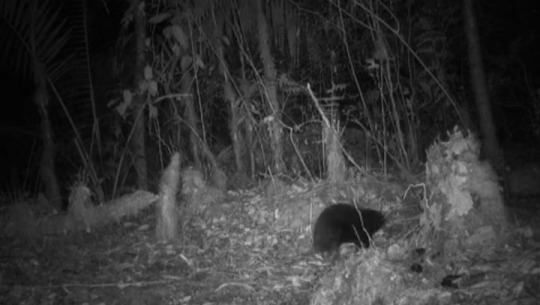
Photo credit: Cyclops Expedition
Attenborough’s Long-Beaked Echidna might somewhat resemble hedgehogs in appearance and behavior, however, they are one of only five species of egg-laying mammals known as monotremes! The other four species are the Short-Beaked Echidna, Western Long-Beaked Echidna, Eastern Long-Beaked Echidna, and the Platypus. The Attenborough’s Long-Beaked Echidna is the smallest species of Echidna and is apparently more closely related to the Short-Beaked Echidna than it is to the other two species of Long-Beakeds. It also possesses a more reddish coloration. All species of monotremes are known for, as I mentioned before, laying eggs instead of giving live birth like placental mammals and marsupials do. Monotremes also lack nipples and instead produce milk for their young out of modified sweat glands like how the early ancestors of all mammals did. Male Platypi/Platypuses (both terms are correct) and Echidnas also have ankle spurs which are highly venomous in the case of the Platypus, but Echidnas seem to have lost their venom and instead use them to help dig. Apparently, they also seasonally secrete a creamy substance their spurs but this, while kinda gross, is harmless.
While the rediscovery of this species is super exciting, we mustn’t forget that Attenborough’s Long-Beaked Echidna is considered Critically Endangered and is still at risk of extinction. Habitat loss and poaching seem to be the biggest threats to this species and many other unique creatures endemic to Oceania.
#monotreme#echidna#new discoveries#critically endangered#science#infodump#animals#endangered species#new guinea#animal news
185 notes
·
View notes
Note
So while I was checking the wiki page for the Knuckles show for updates, it turns out they specifically listed him as a short-beaked echidna.
There’s four existing types: the short-beaked echidna, the Sir David's long-beaked echidna, the eastern long-beaked echidna, and the western long-beaked echidna.
Sure Knuckles is the last of his tribe, but with so little on the tribes histories themselves other than their downfall, it made me wonder if there were four major factions separated by type and if they all had different cultures, goals, etc.
That's an interesting idea. I remember in the comics, he was part of the Knuckles tribe and stuff, so it wouldn’t be surprising that there were differences fractions of their people.
But if that's the case, it was quite the centuries long war if Knuckles' tribe was the only one left standing.
12 notes
·
View notes
Text

In more good news, the Sir David's long-beaked echidna, made an appearance on an expedition team's trail cams! This species hasn't been documented in over 60 years, and was thought to be extinct. This is also the first time a live specimen has been photographed/recorded, as the species was only identified in 1961 by a single dead specimen.
0 notes
Text
Found at last: bizarre, egg-laying mammal finally rediscovered after 60 years
University of Oxford news release:
More than sixty years after it was last recorded, an expedition team has rediscovered an iconic, egg-laying mammal in one of the most unexplored regions of the world. Attenborough's long-beaked echidna, named after famed broadcaster Sir David Attenborough, was captured for the first time in photos and video footage using remote trail cameras set up in the Cyclops Mountains of Indonesia's Papua Province.
Alongside the echidna's rediscovery, the expedition – a partnership between the University of Oxford, Indonesian NGO Yayasan Pelayanan Papua Nenda (YAPPENDA), Cenderawasih University (UNCEN), Papua BBKSDA, and the National Research and Innovation Agency of Indonesia (BRIN), Re:Wild – made many other remarkable finds. These included Mayr's honeyeater, a bird lost to science since 2008; an entirely new genus of tree-dwelling shrimp; countless new species of insects; and a previously unknown cave system. This was despite the difficulties posed by extremely inhospitable terrain, including venomous animals, blood-sucking leeches, malaria, earthquakes, and exhausting heat.
I can't believe we doxxed an echidna wow
1 note
·
View note
Link
Named after Sir David, Attenborough’s long-beaked echidna, has been rediscovered after 60 years.
0 notes
Text


Daily Nature Fun Facts #4
Did you know?
There is a group of mammals called Monotremes, of the order Monotremata, that don't give birth to live young, but lay eggs instead! That's right, they are the only mammals in the world that lay eggs. In all, there are 5 different species within the order Monotremata, the Platypus (top), and the four species of Echidna (bottom): the Short-beaked echidna, Sir David's long-beaked echidna, the Eastern long-beaked echidna, and the Western long-beaked echidna.
1 note
·
View note
Text
Animal of the Day!
Sir David’s Long-Beaked Echidna (Zaglossus attenboroughi)

(Photo by Muse Opiang)
Conservation Status- Critically Endangered
Habitat- Australia; Indonesia
Size (Weight/Length)- 60 cm
Diet- Termites; Worms; Ants
Cool Facts- The Sir David long-beaked echidna is named after my personal hero, Sir David Attenborough. Like all species of echidna, the Sir David’s long-beaked echidna eats a diet of insects by digging with long claws. When threatened, they curl into a ball with their spines flared out to avoid becoming a meal. Completely nocturnal, it has made studying this elusive animal even harder. It was thought that due to habitat destruction, that these echidnas went locally extinct in Indonesia. However, further studies have found evidence of them still nosing around. Due to hunting and deforestation, conservationists are rushing to save this amazing species.
Rating- 12/10 (An amazing animal named after an amazing man.)
#Animal of the day#Animals#Monotreme#Monday#May 9#Sir David's long-beaked echidna#Echidna#biology#science#conservation#the more you know
221 notes
·
View notes
Photo

Sir David's Long-Beaked Echidna
Photograph: D. Parer & E. Parer-Cook/Corbis
34 notes
·
View notes
Photo



The rarest and least-understood species of echidna is Sir David’s long-beaked echidna, or Attenborough’s long-beaked echidna, named for renowned naturalist Sir David Attenborough. The species is known from a single specimen collected in 1961 on Cyclops Mountain (third image). Since then, there have been no sightings, although locals insist there are still echidnas in the area, and echidna tracks and “nose pokes” have been found by ecologists in 2007. The animal is considered a delicacy by natives and is hunted with the use of dogs. It is believed to be the smallest species of echidna alive today.
#echidna#echidnas#long-beaked echidna#sir david's long-beaked echidna#mammal#mammals#animal#animals#monotreme#monotremes#insectivore#insectivores#australia#australian#australian animal#australian animals#Papua New Guinea#new guinea#critically endangered#endangered#endangered species#cyclops mountain
145 notes
·
View notes
Photo
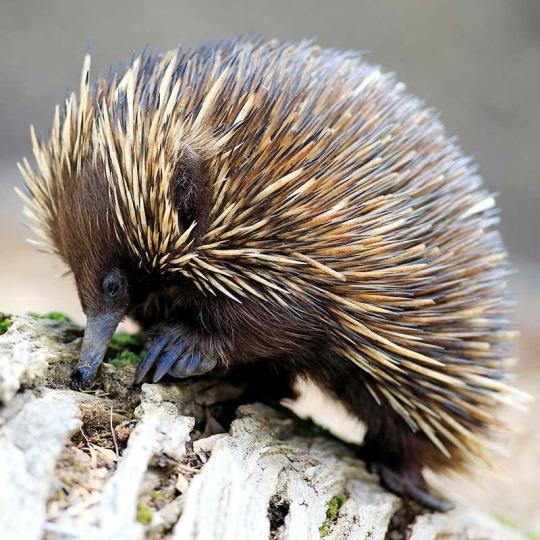
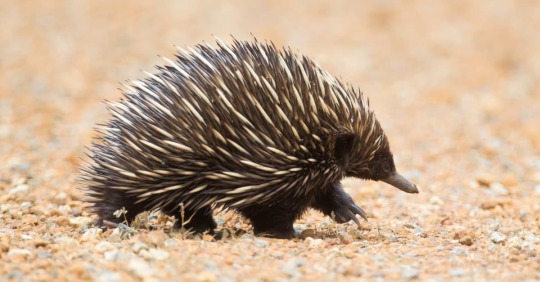
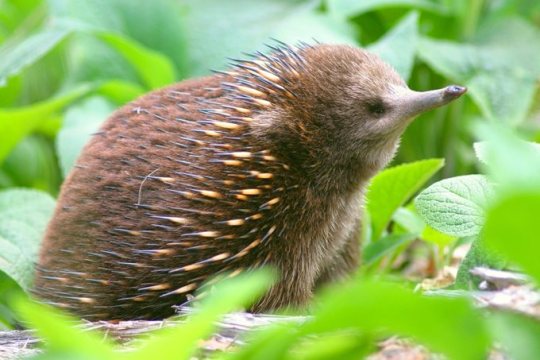

Erroneous Echidnas
Second only to the platypus in infamy, the echidna group is perhaps most known for being an egg-laying mammal. In fact there are four species of Echnida, collectively gathered into the family Tachyglossidae. There are two genera in this family; thee species of echidna-- the western longbeaked (Z. bruijni ), Sir David’s longbeaked (Z. attenboroughi), and the eastern longbeaked (Z. bartoni) -- belong to Zaglossus, while the fourth species, the short beaked echidna (T. aculeatus), is in its own genus Tachyglossus. All four species are endemic to New Guinea, although only the short beaked echidna is found in Australia.
In general echidnas resides in dry forests and woodlands. While the longbeaked echidnas require high humidity environments, the shortbeaked echidna is more felixble and can be found in drier environments like grasslands, arid scrublands, and deserts. While they are not completely subterranean, echidnas spend much of their lives in burrows; either those they dig themselves or those they find abandoned by other species. When aboveground Tachyglossidae will often hide in leaf litter or under logs, where their primary food source is most abundant.
The diets of the two echidna genera are significantly different. Tachyglossus preys on worms and larvae. Zaglossus bartoni specialises in termites and ants due to their longer tongues, which can reach up to 18 cm long and is coated with sticky mucus. Aptly named, the most significant physical difference between the two genera is also related to their diets. The shortbeaked echidna has a nose only a few centimeters long and no more than 400 electroreceptors at the tip, while the longbeaked echidnas sport noses up to 15 cm long and containing over 40,000 electroreceptors.
Aside from their obvious nasal differences, echidnas follow the same rough body plan. They are medium sized; the shortbeak are slightly smaller at 40cm in length and weighing 7 kg, while longbeaks grow up to 100cm and weigh about 10 kg. All four species are covered in a blend of coarse brown or black hair and spines, which they use for defense against predators like dingoes, foxes, and feral pigs. Their feet appear to be on “backwards”, but in reality their claws are turned that way to make digging easier. Like their close cousin the platypus, echidnas have a spur on their hind leg, though it isn’t venomous. The reproductive anatomy is also distinct: the female only has a single rear opening called the cloaca, and the male has a four-headed penis. As if it weren’t unique enough, echidnas have the second lowest body temperature of any mammal at only 33 °C. During their hibernation season, from April to July, the temperature lowers even further as echidnas enter a state of semi-hibernation known as torpor.
Outside of the mating, echidnas are usually solitary, though territories can overlap. The mating season runs from July to September, and Tachyglossidae become sexually mature between 5 and 12 years old. Once a female is located, all the active males in the area will line up to follow her, oldest to youngest, and attempt to mate. Up to 10 males can follow a female, though only one will be successful, and none will contribute to raising his offspring. 22 days after breeding, the female lays a single soft shell in a special pouch in her belly. The young larva-like “puggle” will hatch 10 days later and will suckle at one of two milk patches in the pouch. It takes about a month and a half for the puggle to grow into a recognizable echinda with spines. At this point it leaves its mother’s pouch, though it stays in a specifically dug nursery burrow for a year. In the wild echidnas can live 20 years, and in captivity they last up to 50.
Conservation status: The western and Sir David’s longbeaked echidnas are listed as Critically Endangered by the IUCN; the eastern longbeaked is listed as Vunurable and the shortbeaked echidna is Least Concern. The main threat for all four comes from habitat loss and hunting.
Photos
Jürgen & Christine Sohns
Jukka Jantunen (via Shutterstock)
Muse Opiang
Wayne Lawler
#echidnas#Monotremata#Tachyglossidae#monotremes#mammals#deciduous forests#deciduous forest mammals#scrubland#scrubland mammals#deserts#desert mammals#oceania#australia#animal facts#biology#zoology
119 notes
·
View notes
Text
#bc i forgot to check earlier but monotreme won my extant mammalia subdivision poll#🍕 mikeys musings#also not including subspecies soz
19 notes
·
View notes
Photo

I’ve always wanted to try #the100dayproject, but I know if I try to do it with felting I won’t be able to keep up. So instead I’m going to try doing #100daysofEDGEspecies drawings. I’m not going to put too much pressure on myself to post every single day, but I will commit to getting to 100! I’m sure I’ll get ideas for new woolies to make along the way as well.🙂 The @zsledgeofexistence programme focuses on highlighting and protecting the world’s most Evolutionary Distinct and Globally Endangered (EDGE) species. I’m excited to showcase some of these lesser known and super unique species. 🌱 Day 1/100: Attenborough’s long-beaked echidna. This egg-laying mammal is one of three species of long-beaked echidnas and named in honour of Sir David Attenborough. It lives in the Cyclops Mountains in the Indonesian province of Papua and is considered to be Critically Endangered. The species is known from one specimen collected in 1961. They are very hard to locate, as they are nocturnal and spend their days in shallow burrows or hollow logs. . . . . . #100dayproject #artchallenge #drawingdaily #EDGEspecies #echidna #zaglossus #monotremes #evolutionarybiology #biodiversity #naturalhistory #endangeredspecies #makearteveryday #dailydoodle #procreateart #animaldoodle #the100dayproject2019 #wildlifeart #wildwhimsywoolies https://www.instagram.com/wildwhimsywoolies/p/Bvz1Prrgd6X/?utm_source=ig_tumblr_share&igshid=1euydtxuff6pm
#the100dayproject#100daysofedgespecies#100dayproject#artchallenge#drawingdaily#edgespecies#echidna#zaglossus#monotremes#evolutionarybiology#biodiversity#naturalhistory#endangeredspecies#makearteveryday#dailydoodle#procreateart#animaldoodle#the100dayproject2019#wildlifeart#wildwhimsywoolies
4 notes
·
View notes
Photo

Attenborough’s long-beaked echidna, also known as Sir David’s Long-beaked Echidna, is the smallest and probably most threatened of the three long-beaked echidna species. Echidnas and platypus are the only mammals to lay eggs. The population is unknown and It is Critically Endangered (Population decreasing). It is known from a single specimen collected by a Dutch botanist during an expedition to the Cyclops Mountains in 1961. Despite more recent attempts to search for the species it has remained elusive and was believed extinct by the research community until EDGE team members visited the mountains in 2007. Although no individuals were sighted, echidna signs were found and interviews with local community members revealed that the distinctive animals were still present in the mountains. #echidna #endangeredspecies #endangered #extinction #indonesia #wildlifeofinstagram #procreate with #maxpacks (at Indonesia) https://www.instagram.com/p/B37IRktjRDi/?igshid=1xhijacemvv2j
0 notes